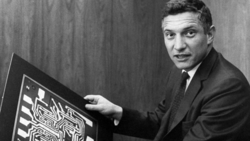Integrated circuit
An integrated circuit (more often called an IC, microchip, silicon chip, computer chip, or chip) is a single piece of specially prepared silicon (or another semiconductor) into which an electronic circuit is etched using photolithography. Silicon chips can contain logic gates, computer processors, memory and special devices. The chip is very fragile and so is normally surrounded by a plastic package to protect it. Electrical contact with the chip is provided through tiny wires that connect the chip to larger metal pins that stick out of the package.
An IC has two main advantages over electronic circuits (or discrete circuits): cost and performance. Cost is low, because millions of transistors can be put onto one chip instead of building a circuit with single transistors. Performance is higher since the components can operate more quickly and use less power.
ICs are designed for different purposes. For example, a chip may be designed just for a calculator, which can only work as a calculator. Integrated circuits can be classified into analog, digital and mixed signal (both analog and digital on the same chip). ICs are found in many household items such as radios, computers, and telephones, and many others.

Invention
An early attempt at combining multiple electronic devices into a single package was the Loewe 3NF vacuum tube in 1926. This integrated vacuum tube contained almost all of the components needed to build a radio receiver. At the time, radio receivers were taxed based on the number of tubes they contained, so combining everything into a single tube resulted in a lower tax.
In 1958 and 1959, two people had the idea for a semiconductor integrated circuit at almost exactly the same time. Transistors had become an everyday thing used in household devices such as radios. They affected everything from radios to phones and at the time manufacturers needed a smaller replacement for vacuum tubes. Transistors were smaller than vacuum tubes, but for some of the newest electronics, for example missile guidance, they were not small enough.
One day in July, while Jack Kilby was working at Texas Instruments, he realized that all parts of a circuit, not just the transistor, could be made out of silicon. At the time, nobody was putting capacitors and resistors into ICs. This would change the future and make it easier to produce and sell integrated circuits. Kilby's boss liked the idea. By September 12, Kilby had built a working model, and on February 6, Texas Instruments filed a patent. Their first "Solid Circuit" was the size of a fingertip.
Meanwhile, in California, another man had the same idea. In January 1959, Robert Noyce was working at the small Fairchild Semiconductor startup company. He also realized a whole circuit could be put into a single chip. While Kilby had worked out the details of making individual components, Noyce thought of a much better way to connect the parts. The design was called a "unitary circuit". All that detail paid off because on April 25, 1961, the patent office awarded the first patent for an integrated circuit to Robert Noyce while Kilby's application was still being analyzed. Today, both men are acknowledged as having independently conceived of the idea.[1]
Generations
| Name | Period | Numbers of transistors on each chip (approximately) |
|---|---|---|
| SSI (Small-Scale Integration) | early 1960s | one chip contains only a few transistors |
| MSI (Medium-Scale Integration) | late 1960s | hundreds of transistors on each chip |
| LSI (Large-Scale Integration) | mid 1970s | tens of thousands of transistors per chip |
| VLSI (Very Large-Scale Integration) | late 20th
century |
hundreds of thousands of transistors |
| ULSI (Ultra-Large Scale Integration) | 21st century | more than 1 million transistors |
※ The difference between VLSI and ULSI is not well defined. As of the mid-2020s, some chips are expected to contain a trillion transistors.[2]
Classification
Integrated circuits can be packaged as DIP (Dual in-line package), PLCC (Plastic leaded chip carrier), TSOP (Thin small-outline package), PQFP (Plastic Quad Flat Pack) and other chip package types. Some small ones are packaged for surface-mount technology. The transistors inside can be bipolar type, which is rare, but which may be needed for circuits needing very high switching speeds. Most, however, are MOSFETs.
Sometime the term IC is also used for a single packaged circuit containing two or more chips -- more accurately called a hybrid IC (HIC) or Multi-chip Module.
Some integrated circuits are called A.I. chips.[3][4]
Integrated Circuit Media
Robert Noyce developed the first monolithic integrated circuit in 1959. The chip was made from silicon.
Dov Frohman, an Israeli electrical engineer who developed the EPROM in 1969–1971
Virtual detail of an integrated circuit through four layers of planarized copper interconnect, down to the polysilicon (pink), wells (greyish), and substrate (green)
A/D converter IC in a DIP
Rendering of a small standard cell with three metal layers (dielectric has been removed). The sand-colored structures are metal interconnect, with the vertical pillars being contacts, typically plugs of tungsten. The reddish structures are polysilicon gates, and the solid at the bottom is the crystalline silicon bulk.
Schematic structure of a CMOS chip, as built in the early 2000s. The graphic shows LDD-MISFET's on an SOI substrate with five metallization layers and solder bump for flip-chip bonding. It also shows the section for FEOL (front-end of line), BEOL (back-end of line) and first parts of back-end process.
A Soviet MSI nMOS chip made in 1977, part of a four-chip calculator set designed in 1970.
Related pages
References
- ↑ "Integrated circuit". PBS.
- ↑ "How We'll Reach a 1 Trillion Transistor GPU - IEEE Spectrum". spectrum.ieee.org. Retrieved 2025-07-31.
- ↑ https://www.power-and-beyond.com/a-brief-overview-of-ai-chips-vs-traditional-chips-a-cbdbdd3b4e40f02399c4d0dda609b886/. Retrieved 2025-07-06
- ↑ https://www.bangkokpost.com/business/general/3063282/us-plans-ai-chip-curbs-on-malaysia-thailand-over-china-concerns?tbref=hp. Retrieved 2025-07-06







